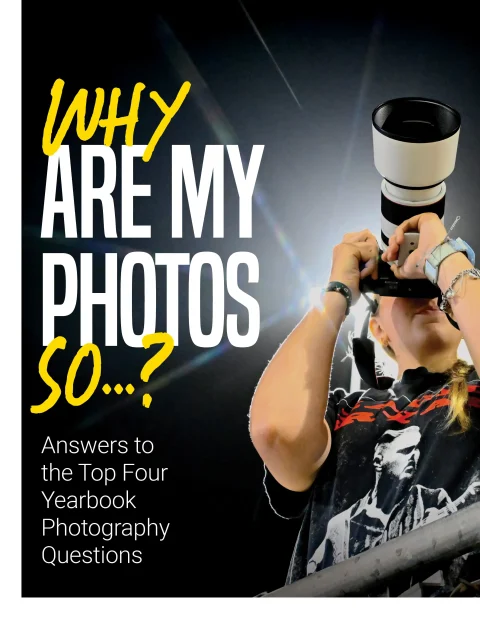For 10 years, I’ve walked into journalism rooms across the country to help yearbook students improve their photography skills. I hear the same questions again and again from new and experienced photographers alike, regardless of the camera model they use. And guess what? That’s a good thing.
These questions aren’t signs of failure. They’re signs of growth – clues that a photographer is paying attention to their images and wants to make them better. Whether you’re just starting out or you’ve already covered a few games or pep rallies, you’ve probably struggled with at least one of the following problems at some point.
Let’s walk through the four most common photography questions students ask and explore easy-to-follow fixes that will make your photos stronger, sharper and more professional.
-
WHY ARE MY PHOTOS SO… DARK?
What’s happening: If your photos are consistently underexposed, especially indoors or at night, it usually means your settings do not allow enough light into the camera. This is a lighting issue, not a camera quality problem.
How to fix it:
- Open up the aperture: A lower f-stop number (such as f/2.8 or f/3.5) opens the lens wider, letting in more light. The wider the opening, the brighter the image.
- Slow down the shutter speed (carefully): Slower shutter speeds let in more light, but if your subject is moving – such as during sports – slowing it too much will cause blur. For most action, aim for 1/500 as a minimum.
- Increase the ISO: ISO controls how sensitive your camera sensor is to light. In bright daylight, ISO 100-400 works well. But in gyms, auditoriums or at night, try raising your ISO to 1600, 3200, or even 6400. While higher ISO may add grain (called “noise”), a slightly noisy photo is still better than a dark one you can’t use at all.
Pro Tip: Try switching to Manual Mode or Shutter Priority (S or Tv) to control these settings better than Auto Mode allows.
-
WHY ARE MY PHOTOS SO… BLUE? (orange, purple, red, green)
What’s happening: Your camera can easily become confused by the lighting in your environment. Light from gym lights, stage spotlights, classrooms and cloudy days all have different “color temperatures.” Your camera uses something called white balance to guess what’s supposed to be white in a scene, but sometimes it’s wrong.
How to fix it:
- Use Auto white balance instead of white balance presets: White balance presets almost always still need customizing and can mess up the next person who is going to use the camera. That’s why I’m not a fan of white balance presets. Auto white balance will get you really close to correct on a regular basis. However, even auto white balance is no match for your terrible gym lights. Here’s how to perfectly customize your auto white balance:
- Set to auto white balance.
- Take a photo.
- Compare your photo to your live subject. What colors are present in your photo that shouldn’t be there?
- Click Menu.
Canon: Under this menu folder (camera folder) look for WB/Shift BKT.
Nikon: Under this menu folder (camera folder) look for White Balance > Auto > press to the right until you see this (Rainbow Axis).
- Filter out the color that needs removed. If it’s blue, move the dial away from blue.
- Take a new photo. Was it far enough? Too far? Keep adjusting until it looks perfect.
Pro Tip: When color customizing your white balance in the camera, look for correct skin tone. Everyone has color differentiation in their cheeks and lips.
-
WHY ARE MY PHOTOS SO… STREAKY?
What’s happening: This usually means your shutter speed is too slow to freeze the motion of your subject. In low-light settings like gyms or fields at dusk, the camera might lower the shutter speed automatically to brighten the shot, but that causes motion blur when subjects move quickly.
How to fix it:
- Use a fast shutter speed: Start with 1/500 for fast action like basketball or soccer. For extremely fast movement (like football or track), try 1/800 or faster if your lighting allows it.
- When you do this, you’ll also need to: Boost ISO and open aperture. Remember, faster shutter speeds let in less light, so balance it by raising ISO and opening the aperture. These three settings work together like a team – adjusting one affects the others.
- Steady your camera: Even when you are not photographing action, a slow shutter speed combined with shaky hands can cause blur. Tuck your elbows in, use a strap for stability or lean against a wall.
Pro Tip: In a low-light gym? Move as close to the action as possible instead of zooming in from far away. Get in the action. Zooming can exaggerate blur and make camera shake harder to avoid.
-
WHY ARE MY PHOTOS SO… NOT IN FOCUS?
What’s happening: You’re trying to photograph a moving subject – maybe a football player charging down the field or a cheerleader dancing at halftime – but your camera keeps focusing on the background instead of the person. One minute your subject is sharp, the next they’re a blur while the wall behind them is perfectly clear.
This happens when your camera is in One Shot (AF-S) mode. In that mode, it focuses once and locks on wherever your focus point happens to land – often a bright jersey in the background or the scoreboard lights. The result? The wrong thing ends up in focus.
How to fix it:
- Switch to AI Servo (Canon) or AF-C (Nikon/Sony): These modes continually adjust focus as your subject moves. Instead of locking focus once, your camera keeps “chasing” the subject.
- Use burst mode: Hold the shutter button down while in AI Servo, and your camera will fire off multiple frames, adjusting focus between each one.
- Focus on the jersey number (for sports): Place your focal point on the jersey number to get consistent focus. The head is too small, the hands move too quickly and the ball moves WAY too quickly.
Pro Tip: Practice tracking. Move your body and zoom smoothly with your subject. AI Servo plus panning can lead to some of your sharpest action shots.
BONUS TIPS TO GUIDE NEW PHOTOGRAPHERS
- Take test shots before the event starts. Go early, take a few test photos and adjust your settings. That way, you’re not panicking during the action.
- Use your camera’s histogram (especially on a bright day). That little graph tells you if your photo is underexposed or overexposed. Aim for a balanced curve, not bunched to one side.
- Learn one setting at a time. Don’t overwhelm yourself by changing everything at once. Master shutter speed first. Then move on to ISO and aperture.
- Review your shots during breaks. Don’t just click and hope. Check your LCD screen for sharpness, exposure and color. Zoom in and check faces during breaks.
FINAL THOUGHTS
Becoming a great photographer doesn’t happen overnight, but every frustrating shot teaches you something valuable. Every underexposed gym photo, streaky football catch and yellow-lit classroom pic is part of the learning process. What matters is that you ask the questions and keep experimenting.
These four common problems – dark photos, strange colors, streaky shots and focus issues – are ones every photographer faces at some point. By learning how to adjust settings like shutter speed, ISO, white balance and focus modes, you’ll not only solve these problems, but you’ll start producing images you’re genuinely proud of.
Keep shooting, keep learning and don’t be afraid to make mistakes. Never delete anything. Some of my favorite photos were happy accidents. Your best shot is never your first one. It could be your 713th one. So go shoot and have some fun.





